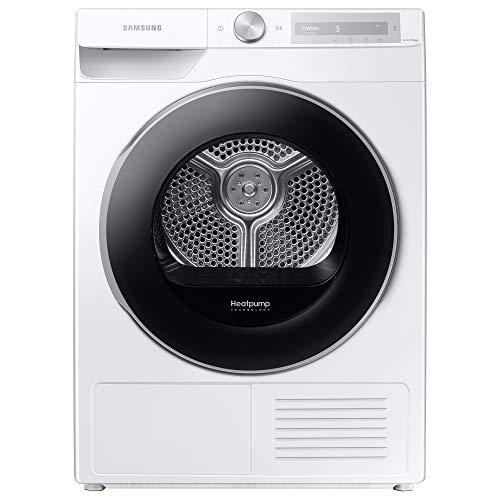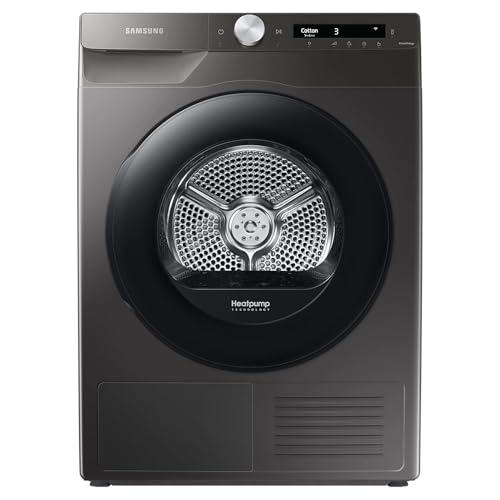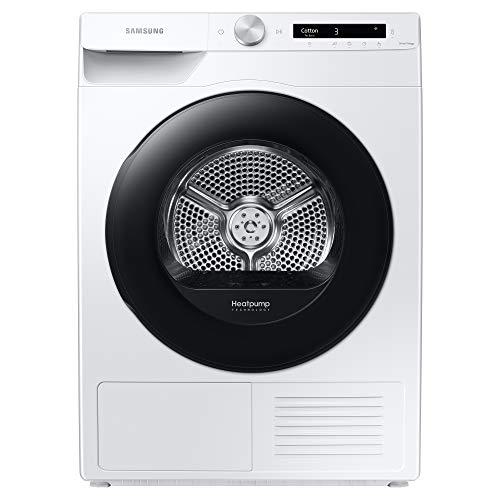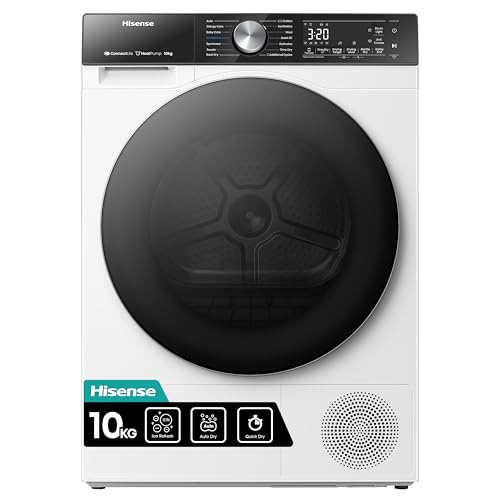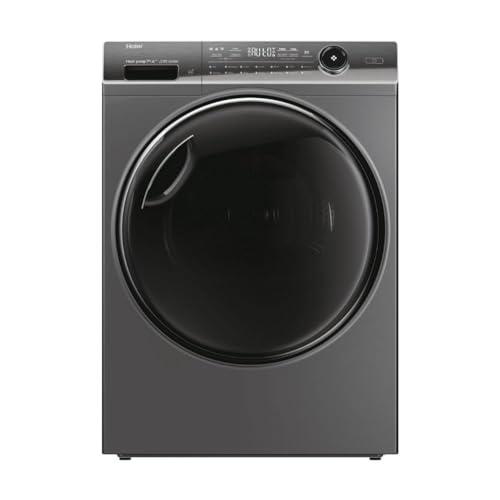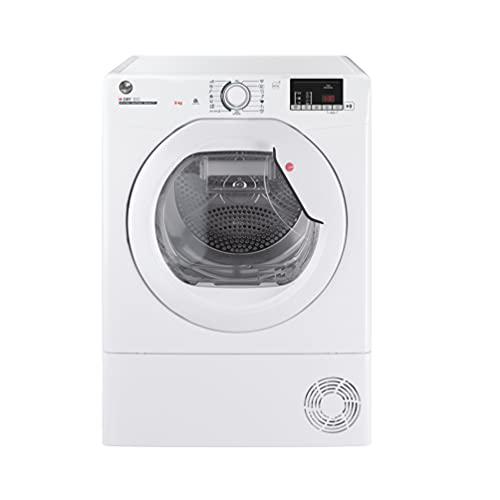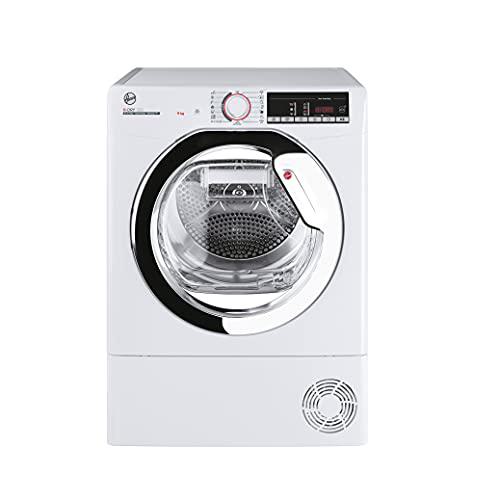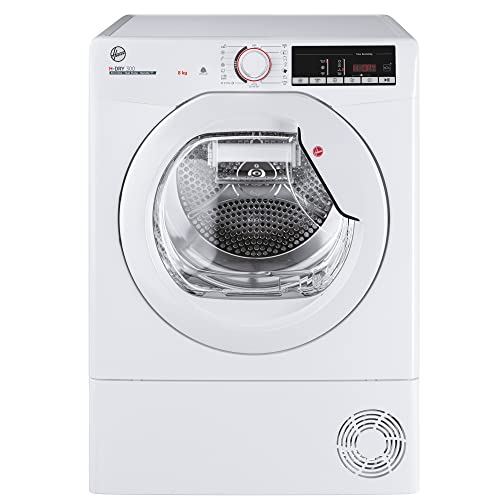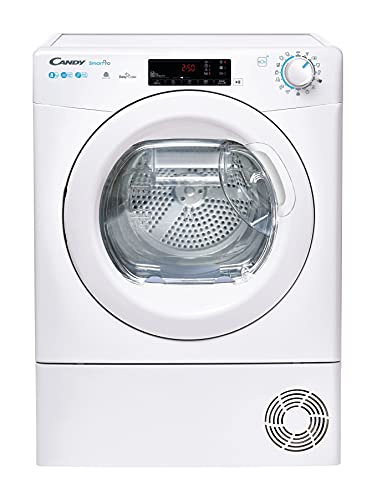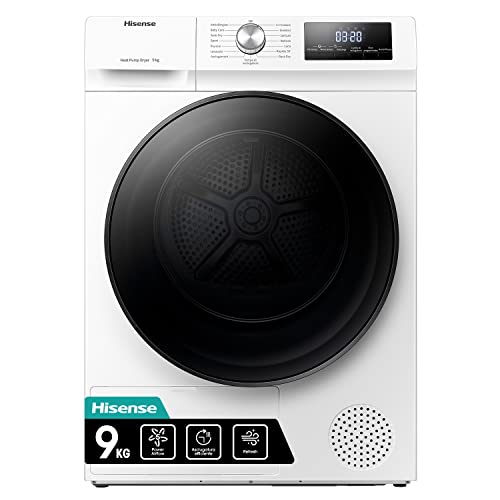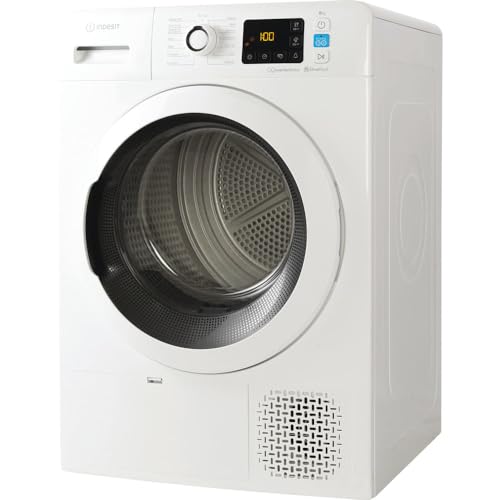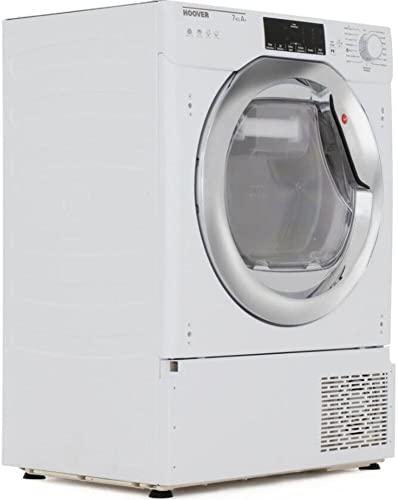Are heat pump dryers good?
Heat pump dryers are energy efficient, consume less electricity than traditional vented or condenser dryers, and operate at lower temperatures, which helps protect fabrics. They recycle warm air instead of releasing it, reducing energy use. Many models include features like humidity sensors, smart diagnosis, and anti-crease functions. Although they take longer to dry clothes, they save energy and lower electricity costs over time.
The best heat pump tumble dryers (with the highest overall score) are as follows.
- Samsung DV90T6240LH Series 6 (Overall score: 8.9 points; capacity: 9 kg)
- Samsung DV90T5240AN Series 5+ (Overall score: 8.79 points; capacity: 9 kg)
- Samsung DV90T5240AW/S1 DV5000T (Overall score: 8.79 points; capacity: 9 kg)
The following list includes the best heat pump tumble dryers with the highest user rating.
- Samsung DV80TA020AX Series 5 (User rating: 9.36 points; capacity: 8 kg)
- Samsung DV90T5240AN Series 5+ (User rating: 9.36 points; capacity: 9 kg)
- Samsung DV90T5240AW/S1 DV5000T (User rating: 9.36 points; capacity: 9 kg)
Note: Products currently available are listed first.
What are the main advantages of heat pump tumble dryers?
Heat pump tumble dryers have the following advantages compared to condenser and air-vented dryers:
- Better energy efficiency: 44% of heat pump tumble dryers have an A+++ energy rating, while none of the condenser or air-vented dryers reach this class. Heat pump tumble dryers recycle hot air to dry clothes at lower temperatures.
- Lower energy consumption: Heat pump tumble dryers use 1.85 kWh per full load cycle, while condenser dryers use 4.74 kWh and air-vented dryers use 4.45 kWh. Annual energy consumption is 227 kWh for heat pump tumble dryers, 561 kWh for condenser dryers, and 510 kWh for air-vented dryers.
- More inverter motors: 53% of heat pump tumble dryers include an inverter motor, compared to 4% of condenser dryers and less than 0% of air-vented dryers.
- More specialized drying cycles: Heat pump tumble dryers more often include cycles like Duvet and Hygiene compared to condenser and air-vented dryers.
- More advanced features: Heat pump tumble dryers more often include an ECO function, ECO indicator, Wi-Fi, smart pairing, interior light, special drum design, reversible door, antivibration design, and a special filter type.
- Gentler on clothes: Heat pump tumble dryers dry at lower temperatures, which protects delicate fabrics.
- Quieter operation: Heat pump tumble dryers operate at 65 dB on average, which is 2 dB quieter than condenser dryers (67 dB) and 1.5 dB quieter than air-vented dryers (66.5 dB).
What are the main disadvantages of heat pump tumble dryers?
Heat pump tumble dryers have the following disadvantages compared to condenser and air-vented dryers:
- Higher price: Heat pump tumble dryers cost an average of 630 €, which is 250 € more than condenser dryers (380 €) and 350 € more than air-vented dryers (280 €).
- Heavier weight: Heat pump tumble dryers weigh an average of 48 kg, which is 13 kg more than condenser dryers (35 kg) and 20 kg more than air-vented dryers (28 kg).
- Longer ECO cycle: The ECO cycle in heat pump tumble dryers takes an average of 205 minutes, which is 55 minutes longer than condenser dryers (150 min) and 65 minutes longer than air-vented dryers (140 min).

Which brands make the best heat pump tumble dryers?
The best heat pump tumble dryer brands (with the highest overall score) are as follows.
- Samsung (Average overall score: 8.6 points)
- LG (Average overall score: 8.3 points)
- Hoover (Average overall score: 7.8 points)
The following chart ranks heat pump dryers by brand based on their overall score.
[horizontal-chart-42957945671028089]
Which heat pump tumble dryer brands have the highest user ratings?
The heat pump tumble dryer brands with the highest user ratings are as follows.
- Samsung (Average user ratings: 9.1 points)
- Hisense (Average user ratings: 9.1 points)
- Siemens (Average user ratings: 8.9 points)
The chart below highlights user ratings for heat pump dryers across different brands.
[horizontal-chart-42107244744027717]
How much do heat pump dryers cost?
Heat pump tumble dryers cost between 350 € and 1,500 €, with an average price of 630 €. They are about 250 € more expensive than condenser dryers (380 €) and 350 € more expensive than air-vented dryers (280 €).
The price distribution for heat pump dryers is shown in the following chart.
[vertical-chart-20961121021519790]
The chart below compares drying technologies for dryers based on their price.
[horizontal-chart-33603235935923907]
What should you consider while choosing the best heat pump tumble dryer?
When choosing the best heat pump tumble dryer, consider the following:
- Energy efficiency: Look for models with an A+++ rating to reduce electricity costs.
- Capacity: Choose a dryer that matches your laundry needs, such as 8 kg or 9 kg models for larger loads.
- Noise level: Quieter models operate below 65 dB, which is useful for shared spaces.
- Drying programs: Some models include special cycles like Duvet and Hygiene, which provide better care for specific fabrics.
- Features: Look for options like Wi-Fi connectivity, smart pairing with a washing machine, humidity sensors, anti-crease function, and an interior light.
- Motor type: Inverter motors are more durable and energy efficient than standard motors.
- Drum design: Special drum patterns help prevent fabric damage.
- Size and weight: Check dimensions and weight to make sure the dryer fits your space and is easy to install.
- Warranty: Longer warranties, especially on the motor, indicate better durability and reliability.
What capacity do the heat pump dryers have?
Heat pump tumble dryers have a capacity between 7 and 11 kg. The most common capacities are 8 kg (48%), followed by 9 kg (35%), 7 kg (10%), 10 kg (7%), and over 11 kg (less than 1%).
Drum volume ranges from 99 to 125 litres, with an average of 118 litres, which is the same as the market average.
Depth varies from about 46 to 84 cm, so there are also slim heat pump tumble dryers available.
Weight ranges from 37 to 62 kg, with an average of about 48 kg. This is 13 kg heavier than an average condenser dryer (35 kg) and 20 kg heavier than an average air-vented tumble dryer (28 kg).
The chart below illustrates the capacity distribution for heat pump dryers.
[pie-chart-19850319420118498]
The best 7 kg heat pump tumble dryers are as follows.
- Hoover H-DRY 300 BATDH7A1TCE (Overall score: 7.44 points)
- Hoover H-DRY 500 ND4H7A2TCBEX (Overall score: 7.99 points)
The best 8 kg heat pump tumble dryers are as follows.
- Hoover H-DRY 500 NDEH8A2TCEXS (Overall score: 7.99 points)
- Hoover H-DRY 300 HLEH8A2DE (Overall score: 7.86 points)
The following list presents the best 9 kg heat pump tumble dryers.
- Samsung DV90T6240LH Series 6 (Overall score: 8.9 points)
- Samsung DV90T5240AN Series 5+ (Overall score: 8.79 points)
Note: Products currently available are listed first.
How energy-efficient are heat pump dryers?
Heat pump tumble dryers have energy classes ranging from A+++ to A+. 44% belong to class A+++, 50% to class A++, and 6% to class A+. There are no heat pump dryers in class B or C.
They consume between 1.3 and 2.9 kWh per cycle in full load (average 1.85 kWh) and between 0.7 and 1.8 kWh per cycle in half load (average 1.03 kWh). This is more energy-efficient than condenser dryers (4.74 kWh per full load, 2.56 kWh per half load) and air-vented dryers (4.45 kWh per full load, 2.27 kWh per half load).
Annual energy consumption ranges from 160 to 340 kWh, with an average of 227 kWh, which is much lower than condenser dryers (561 kWh) and air-vented dryers (510 kWh).
Water recovery efficiency classes range from A to C, with class B being the most common. 29% of heat pump dryers belong to class A, 71% to class B, and less than 1% to class C. This is better than condenser dryers, where only 3% belong to class A, 55% to class B, and the rest to class C.
Energy efficiency classes for heat pump dryers are represented in the following chart.
[pie-chart-30164729741022640]
The following chart displays the distribution of energy consumption per full load cycle for heat pump dryers.
[vertical-chart-49603450417830433]
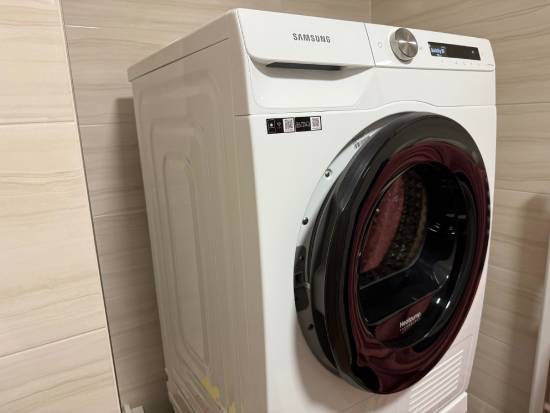
How loud are heat pump dryers?
Heat pump tumble dryers have a noise level between 58 and 69 dB, with an average of 65 dB, which matches the market average.
They are about 2 dB quieter than condenser dryers (67 dB) and 1.5 dB quieter than air-vented dryers (66.5 dB).
How many drying programs do heat pump tumble dryers offer?
Heat pump tumble dryers have between 9 and 22 drying programs, with an average of 14. In comparison, condenser dryers have an average of 15 programs, while air-vented dryers have only 5.
All heat pump dryers include basic programs such as Cottons, Synthetics, and Mix. Most models also include the following cycles:
- Wool: 96% of models
- Refresh: 78%
- Outdoor/Sport: 88%
- Shirt: 77%
Many models feature additional specialized programs:
- Jeans: 47%
- Duvet: 63%
- Hygiene: 41%
- Bed Linen: 43%
- Allergy: 31%
- Baby Care: 24%
The ECO cycle in heat pump dryers takes between 150 and 370 minutes, with an average of 205 minutes (15 minutes longer than the market average of 190 minutes). In comparison, the ECO cycle in condenser dryers takes an average of 150 minutes, while air-vented dryers take 140 minutes.
The number of drying programs available in heat pump dryers is displayed in the chart below.
[vertical-chart-31915332233324246]
Which drying functions heat pump dryers have?
Heat pump tumble dryers often include a gentle drying function (61%) and silent function (34%), but only a few models have a fast function (9%).
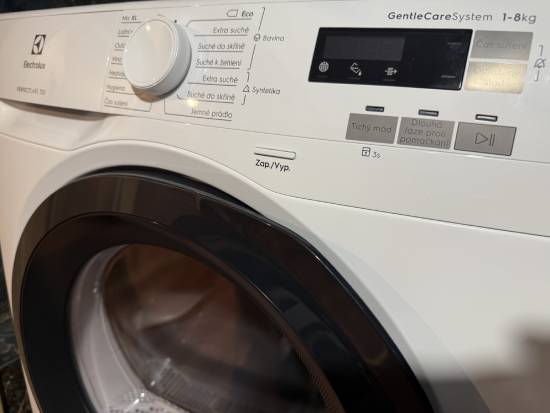
What features do heat pump dryers include?
Heat pump dryers include from 4 to 18 advanced features, and most models have around 8. You will find a similar number of features in condenser dryers (average 8), but air vented models usually have only 1 to 6 features.
Almost all heat pump tumble dryers include humidity sensors, delay start option, and selectable drying level. Many models also include:
- Laundry detection system (50% of models)
- Memory function (33%)
- Wi-Fi connectivity (32%)
- Bluetooth (15%)
- AI technology (8%)
- Smart diagnosis (31%)
- Scan & Dry (15%)
- ECO indicator (26%)
- ECO function (11%)
- Smart pairing (28%)
69% of heat pump dryers include a special drum design. 60% have an interior light, and 65% use a special filter type. You also find antivibration design in 37% of models and a reversible door in 33%.
Most heat pump dryers (97%) include a post-drying movement feature, which prevents creases if you remove the clothes later. 70% use bidirectional movement, which helps avoid tangling and bunching.
Inverter motors appear in 53% of heat pump dryers. In comparison, only 4% of condenser dryers and none of the air vented dryers use them.

